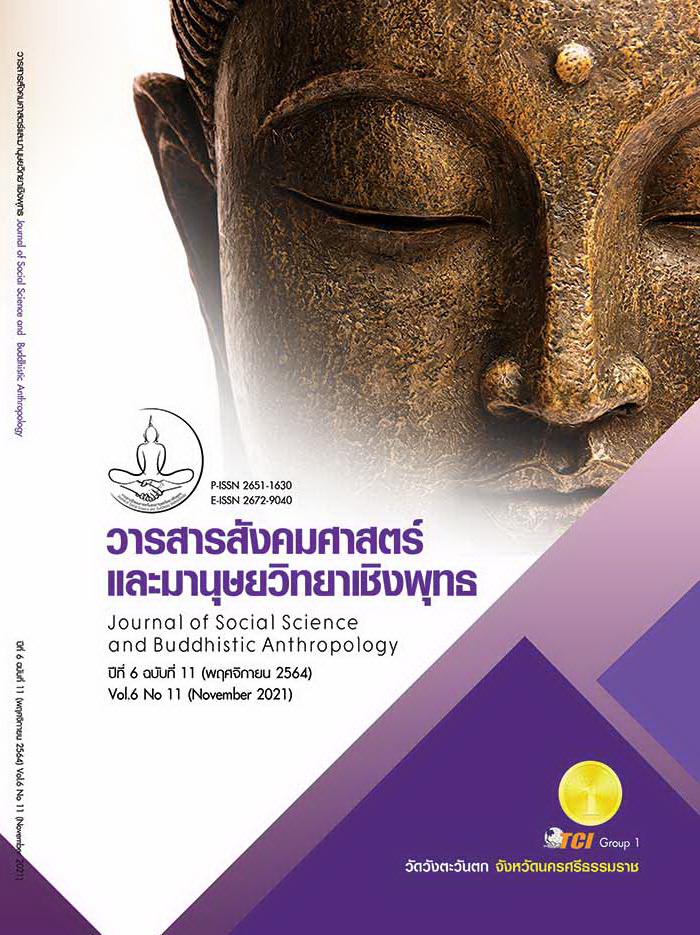การวิเคราะห์องค์ประกอบเชิงยืนยันสุขภาวะทางจิต ของนิสิตมหาวิทยาลัยมหาสารคาม
คำสำคัญ:
การวิเคราะห์องค์ประกอบเชิงยืนยัน, สุขภาวะทางจิต, นิสิตมหาวิทยาลัยบทคัดย่อ
บทความวิจัยนี้มีวัตถุประสงค์เพื่อศึกษาสุขภาวะทางจิตของนิสิตมหาวิทยาลัยมหาสารคาม และตรวจสอบความสอดคล้องระหว่างโมเดลโครงสร้างองค์ประกอบสุขภาวะทางจิตของนิสิตมหาวิทยาลัยมหาสารคาม ซึ่งกลุ่มตัวอย่างที่ใช้ในวิจัย ได้แก่ นิสิตระดับปริญญาตรี มหาวิทยาลัยมหาสารคาม ปีการศึกษา 2563 จำนวน 645 คน สุ่มตัวอย่างแบบแบ่งชั้น เครื่องมือที่ใช้เป็นแบบวัดสุขภาวะทางจิตของนิสิตมหาวิทยาลัยมหาสารคามที่ผู้วิจัยได้สร้างขึ้นมีค่าความเชื่อมั่นเท่ากับ 0.94 และวิเคราะห์ข้อมูลด้วยสถิติเชิงพรรณนาและวิเคราะห์องค์ประกอบเชิงยืนยันสุขภาวะทางจิตของนิสิตมหาวิทยาลัยมหาสารคาม ด้วยวิธีวิเคราะห์องค์ประกอบเชิงยืนยันโดยใช้โปรแกรมคอมพิวเตอร์สำเร็จรูป ผลการวิเคราะห์องค์ประกอบเชิงยืนยันอันดับสอง พบว่า สุขภาวะทางจิตของนิสิตมหาวิทยาลัยมหาสารคามประกอบด้วย 6 องค์ประกอบ ซึ่งโมเดลองค์ประกอบสุขภาวะทางจิตของนิสิตมหาวิทยาลัยมหาสารคามมีความเหมาะสมพอดีกับข้อมูลเชิงประจักษ์ ซึ่งมีน้ำหนักองค์ประกอบมาตรฐานอยู่ในเกณฑ์สูงอย่างมีนัยสำคัญทางสถิติที่ระดับ .05 โดยมีค่าน้ำหนักองค์ประกอบอยู่ระหว่าง 0.714 ถึง 0.995 และผลการตรวจสอบค่าดัชนีวัดระดับความกลมกลืนระหว่างโมเดลกับข้อมูลเชิงประจักษ์พบว่ามีค่าไค - แสควร์ (χ2) เท่ากับ 1374.981 ที่องศาอิสระ 945 มีความน่าจะเป็น (P - value) เท่ากับ 0.000 ค่าดัชนี /df เท่ากับ 1.518 ค่าดัชนีวัดระดับความกลมกลืน (GFI) เท่ากับ 0.910 ค่าดัชนีวัดระดับความกลมกลืนที่ปรับค่าแล้ว (AGFI) เท่ากับ 0.900 ดัชนีความเหมาะสมพอดีเปรียบเทียบ (CFI) เท่ากับ 0.968 ซึ่งมีค่าสูงตามเกณฑ์ ค่าดัชนีรากกำลังสองเฉลี่ยของเศษเหลือ (SRMR) เท่ากับ 0.038 และค่ารากของค่าเฉลี่ยกำลังสองของความคลาดเคลื่อนโดยประมาณ (RMSEA) เท่ากับ 0.027 แสดงว่าโมเดลตามสมมติฐานสอดคล้องกับข้อมูลเชิงประจักษ์อยู่ในเกณฑ์ดี
เอกสารอ้างอิง
กิ่งแก้ว ทรัพย์พระวงศ์. (2558). บทบาทการส่งผ่านของอัตมโนทัศน์ในการศึกษาอิทธิพลของการคิดเชิงบวกและภูมิหลังของนักศึกษาที่มีต่อสุขภาวะทางจิต. วารสารวิธีวิทยาการวิจัย, 28(1), 49-73.
ธาณัฐดา สิริโสนแก้ว. (2563). รายงานผลข้อมูลนิสิตที่มารับบริการคลินิกสุขภาพจิต โรงพยาบาลสุทธาเวช. ใน มลฤดี เชาวรัตน์ (ประธาน), ประชุมการขับเคลื่อนการให้คำปรึกษานิสิต มหาวิทยาลัยมหาสารคาม [Symposium]. มหาวิทยาลัยมหาสารคาม.
ปิยะนุช จิตตนูนท์ และสุมาลี วังธนากร. (2561). สมดุลชีวิตนักศึกษามหาวิทยาลัยในภาคใต้. วารสารพยาบาลสงขลานครินทร์, 38(4), 103-113.
พันธุ์นภา กิตติรัตนไพบูลย์ และคณะ. (2563). แนวโน้มและปัจจัยที่มีผลต่อระดับสุขภาพจิตคนไทย: การสำรวจระดับชาติ ปี พ.ศ. 2561. วารสารสุขภาพจิตแห่งประเทศไทย, 28(2), 121-135.
ภมรพรรณ์ ยุระยาตร์. (2554). การศึกษาและพัฒนาความผาสุกทางจิตใจของนิสิตนักศึกษาในมหาวิทยาลัย. กรุงเทพมหานคร: มหาวิทยาลัยศรีนครินทรวิโรฒ.
ลักษณา สกุลทอง และคณะ. (2560). การพัฒนาโมเดลการฝึกอบรมเพื่อพัฒนาความผาสุกทางจิตใจของนิสิตนักศึกษาในมหาวิทยาลัย. วารสารราชพฤกษ์, 16(1), 75-87.
สำนักงานกองทุนสนับสนุนการสร้างเสริมสุขภาพ. (2562). จับตาทิศทางสุขภาพคนไทย ปี 2563. เรียกใช้เมื่อ 15 กรกฎาคม 2563 จาก http://resourcecenter.thaihealth.or.th/files/90
อัชฌา ชื่นบุญ และชุติมา แสงดารารัตน์. (2560). ความผาสุกทางจิตใจ และบรรยากาศในการเรียนที่ส่งผลต่อผลการเรียนรู้ของนักศึกษาวิทยาลัยเซนต์หลุยส์. วารสารปัญญาภิวัฒน์, 9(ฉบับพิเศษ), 193-203.
Anand, K. & Nagle, Y. K. (2016). Perfectionism as predictor of psychological wellbeing among college students. Global Journal of Human - Social Science, 16(5), 34-40.
Arnett, J. J. (2004). Emerging adulthood: The winding road from the late teens through the twenties. New York: Oxford University Press.
Auerbach, R. P. et al. (2010). WHO World Mental Health Surveys International College Student Project: Prevalence and distribution of mental disorders. Journal of Abnormal Psychology, 127(7), 623-638.
Auerbach, R. P. et al. (2016). Mental disorders among college students in the World Health Organization World Mental Health Surveys. Psychological Medicine, 46(14), 1-16.
Auerbach, R. P. et al. (2018). WHO World Mental Health Surveys International College Student project: Prevalence and distribution of mental disorders. Journal of Abnormal Psychology, 127(7), 623-638.
Auyeung, L. & Mo, P. K. H. (2019). The efficacy and mechanism of online positive psychological intervention (PPI) on improving well - being among Chinese university students: a pilot study of the best possible self (BPS) intervention. Journal of Happiness Studies, 20(8), 2525-2550.
Bayram, N. & Bilgel, N. (2008). The prevalence and socio - demographic correlations of depression, anxiety and stress among a group of university students. Social Psychiatry and Psychiatric Epidemiology, 43(8), 667-672.
Chen, L. et al. (2013). Depression among Chinese University Students: Prevalence and socio - demographic correlates. PLoS ONE, 8(3), 1-6.
Clarke, P. J. et al. (2001). Measuring psychological well - being in the Canadian study of health and aging. International Psychogeriatrics, 13(s1), 79-90.
Comrey, A. L. & Lee, H. B. (1992). Interpretation and Application of Factor Analytic Results. In Comrey, A. L. & Lee, H. B. (Eds.), A First Course in Factor Analysis (p. 2). Hillsdale: NJ: Lawrence Eribaum Associates.
Eisenberg, D. et al. (2013). Mental health in American colleges and universities: Variation across student subgroups and across campuses. The Journal of Nervous and Mental Disease, 201(1), 60-67.
Eisenberg, D. et al. (2009). Mental health and academic success in college. The BE Journal of Economic Analysis & Policy, 9(1), 1-40.
Evans, N. J. et al. (2009). Student development in college: Theory, research, and practice. San Francisco: John Wiley & Sons.
Ferrari, A. J. et al. (2014). The burden attributable to mental and substance use disorders as risk factors for suicide: findings from the Global Burden of Disease Study 2010. PloS one, 9(4), 1-11.
GBD 2015 Disease and Injury Incidence and Prevalence Collaborators. (2015). Global, regional, and national incidence, prevalence, and years lived with disability for 310 diseases and injuries, 1990-2015: A systematic analysis for the Global Burden of Disease Study 2015. The Lancet, 388(10053), 1545-1602.
Goldman-Mellor, S. J. et al. (2014). Suicide attempt in young people: A signal for long-term health care and social needs. JAMA Psychiatry, 71(2), 119-127.
Herrman H. et al. (2004). Promotion mental health: concepts - emerging evidence - practice: summary report. Geneva: World Health Organization.
Huppert, F. A. (2009). Psychological well-being: Evidence regarding its causes and consequences. Applied Psychology: Health and Well - Being, 1(2), 137-164.
Hysenbegasi, A. et al. (2005). The impact of depression on the academic productivity of university students. Journal of Mental Health Policy and Economics, 8(3), 145-151.
Ibrahim, A. K. et al. (2013). A systematic review of studies of depression prevalence in university students. Journal of Psychiatric Research, 47(3), 391-400.
Ishii, T. et al. (2018). What kinds of factors affect the academic outcomes of university students with mental disorders? A retrospective study based on medical records. Asian Journal of Psychiatry, 32(2018), 67-72.
Kalantarkousheh, S. M. & Navarbafi, F. (2012). Reliability and exploratory factor analysis of psychological well - being in a persian sample. Science Series Data Report, 4(1), 11-27.
Kessler, R. C. et al. (1995). Social consequences of psychiatric disorders, I: Educational attainment. The American Journal of Psychiatry, 152(7), 1026-1032.
Kleinert, S. (2007). Adolescent health: an opportunity not to be missed. The Lancet, 9567(369), 1057-1058.
Linley, P. A. et al. (2009). Measuring happiness: The higher order factor structure of subjective and psychological well - being measures. Personality and Individual Differences, 47(8), 878-884.
Marsh, H. W. & Craven, R. G. (2006). Reciprocal effects of self - concept and performance from a multidimensional perspective: Beyond seductive pleasure and unidimensional perspectives. Perspectives on psychological science, 1(2), 133-163.
Niederkrotenthaler, T. et al. (2014). Future risk of labour market marginalization in young suicide attempters - A population-based prospective cohort study. International Journal of Epidemiology, 43(5), 1520-1530.
Rapuano, V. (2019). Psychological well - being and its relationship with the academic achievement of Lithuanian students. Socialiniai tyrimai, 42(2), 44-51.
Rasulzada, F. (2007). Organizational creativity and psychological well - being. In Doctoral Thesis. Lund University.
Roslan, S. et al. (2017). Psychological well - being among postgraduate students. Acta Medica Bulgarica, 44(1), 35-41.
Ryff, C. D. & Keyes, C. L. M. (1995). The structure of psychological well - being revisited. Journal of personality and social psychology, 69(4), 719-727.
Ryff, C. D. (1989). Happiness is everything, or is it? Explorations on the meaning of psychological well - being. Journal of Personality and Social Psychology, 57(6), 1069-1081.
Song, Y. et al. (2008). Depression in college: depressive symptoms and personality factors in Beijing and Hong Kong college freshmen. Comprehensive Psychiatry, 49(5), 496-502.
Stewart-Brown, S. et al. (2000). The Health of students in institutes of higher education: An important and neglected public health problem. Journal of Public Health, 22(4), 492-499.
Udhayakumar, P. & Illango, P. (2018). Psychological wellbeing among college students. Journal of Social Work Education and Practice, 3(2), 79-89.
Van Noorden, T. H. J. & Bukowski, W. M. (2017). Social Development. In Slater, A. & Bremner, J. G. (Eds.), An Introduction to Developmental Psychology. (3th ed.) (pp. 577 - 610). NJ: John Wiley & Sons.
Winefield, H. R. et al. (2012). Psychological well - being and psychological distress: is it necessary to measure both. Psychology of Well - Being: Theory, Research and Practice, 2(1), 1-14.
World Health Organization. (2017). World Health Organization. Retrieved April 21, 2019, from http://apps.who.int/iris/bitstream/handle/10665/254610/WHO-MSD-MER-2017.2-eng.pdf;sequence=1.
World Health Organization. (2008). Global tuberculosis control: surveillance, planning, financing: WHO report 2008. Switzerland: World Health Organization.








